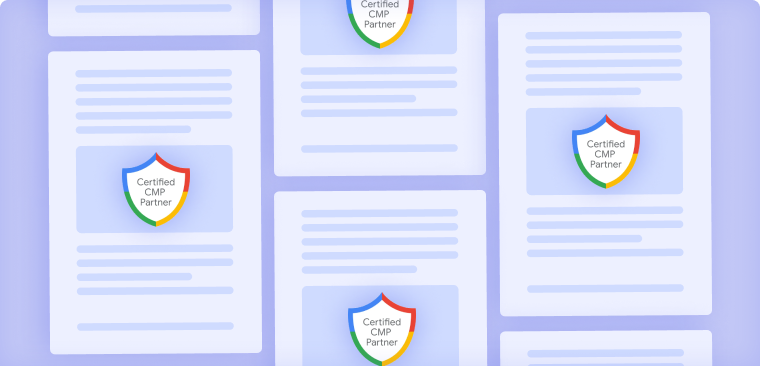Is Google Consent Mode Enough for GDPR Compliance
July 25, 2025
•
4 min read
Table of contents
back
to the top
Is Google Consent Mode Enough for GDPR Compliance?
Google Consent Mode has become a central component for websites and advertisers aiming to balance user privacy with data-driven insights. But a key question remains: Is Google Consent Mode alone sufficient for full GDPR compliance?
In this post, we’ll explore what Consent Mode does, what it doesn’t do, and why relying on it alone could leave you exposed to compliance risks.

What Is Google Consent Mode?
Google Consent Mode is an API that adjusts the behavior of Google tags (like Google Analytics and Google Ads) based on a user's consent status. It allows you to:
- Load tags before consent is given.
- Delay or anonymize data collection based on user choices.
- Preserve conversion modeling and performance insights even with limited data.
Consent Mode v2 (required since March 2024) introduced two new consent parameters:
ad_user_data: for consent to use personal data for ads.ad_personalization: for consent to personalized ads.
These were added to support Google’s obligations under the EU Digital Markets Act (DMA) and enhance GDPR alignment.
The Limits of Google Consent Mode
Despite its benefits, Google Consent Mode is not a standalone GDPR solution. Here's why:
1. It Only Covers Google Services
Consent Mode only governs how Google tags behave. It does not manage:
- Non-Google trackers (like Facebook Pixel, Hotjar, LinkedIn Insight Tag, etc.).
- Custom scripts or third-party cookies outside the Google ecosystem.
GDPR compliance requires full control over all tracking technologies, not just Google's.
2. It Doesn’t Obtain Consent
Google Consent Mode depends on another layer: a Consent Management Platform (CMP).
You still need to:
- Display a compliant consent banner.
- Collect affirmative user consent (opt-in).
- Provide granular choices (e.g., different purposes or vendors).
- Keep an auditable log of consent.
Google Consent Mode reacts to consent; it does not request or store it.
3. No Legal Basis Without Explicit Consent
Under GDPR:
"Processing personal data requires a legal basis. Consent is one such basis but it must be freely given, informed, and explicit."
Even if Consent Mode reduces data collection for users who decline, it does not establish a lawful basis for data processing on its own. You must ensure:
- Transparent disclosures (e.g., via privacy policies).
- Purpose-specific consent before data is sent to third parties.
What Google Recommends
Even Google makes it clear in its documentation:
"Consent Mode alone does not fulfill legal requirements. You must implement it alongside a compliant CMP."
In fact, Google has partnered with Google-certified CMPs to help publishers implement Consent Mode v2 correctly. Failure to do so can lead to:
- Data loss in Google Ads/Analytics.
- Account restrictions or ad serving issues.
- Potential GDPR enforcement action.
So, Is Google Consent Mode Enough?
No, Google Consent Mode is not enough for full GDPR compliance. While it plays an important technical role, it only addresses specific aspects of the compliance puzzle.
To break it down:
- Consent Mode can control the behavior of Google tags, such as Google Analytics and Google Ads, by delaying or anonymizing data collection based on user consent status.
- It does not block or manage non-Google scripts, such as Meta Pixel, Hotjar, or other third-party trackers.
- It does not display a consent banner or user interface for gathering consent. That functionality must come from a separate CMP.
- It does not log or store user consent choices, a key GDPR requirement.
- It does not provide users with granular choices about individual purposes or vendors, which is essential under GDPR and the Transparency & Consent Framework (TCF).
- Most importantly, it does not establish a legal basis for processing personal data. GDPR requires explicit, informed, and freely given consent before processing.
Even Google clearly states in its official documentation:
"Consent Mode alone does not fulfill legal requirements. You must implement it alongside a compliant CMP."
Google also emphasizes the need for using a Google-certified CMP — particularly in the context of Consent Mode v2, which supports the DMA and expands on GDPR expectations.
What You Need for GDPR Compliance
To be truly compliant, your website should combine:
- A Google-certified CMP to gather, manage, and log consent.
- Google Consent Mode v2, correctly implemented via the CMP.
- A clear privacy policy explaining your data practices.
- Granular consent choices (per purpose/vendor).
- Audit trails and user-friendly consent management tools.
✅ Final Thoughts
Google Consent Mode is a step forward for privacy-friendly analytics and advertising, but it is not a silver bullet.
To meet GDPR obligations, you need a holistic consent strategy — one that includes Consent Mode, a certified CMP, and full coverage of all tracking technologies.
📚 Sources
Explore further

How to Choose a Certified Google CMP Partner
Choose a certified Google CMP partner with Google certification, privacy law compliance, user-friendly features, and reliable support.
December 15, 2024
2 min

Why Your IP Address Could Be Personal Data (And What That Means for GDPR Compliance)
IP addresses can be personal data under GDPR. Learn why, avoid common violations, and use mapping, anonymization & informed consent to stay compliant and build trust.
June 13, 2025
7 min

What Happens If You Ignore Cookie Laws? Real Cases, Real Fines
Ignoring cookie laws can lead to serious fines and bad press. Here are real cases showing what happens when companies don’t comply.
April 14, 2025
5 min


